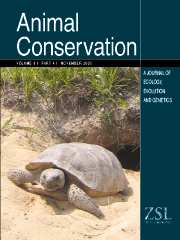Crossref Citations
This article has been cited by the following publications. This list is generated based on data provided by
Crossref.
Banks, Sam C.
Piggott, Maxine P.
Stow, Adam J.
and
Taylor, Andrea C.
2007.
Sex and sociality in a disconnected world: a review of the impacts of habitat fragmentation on animal social interactionsThis review is one of a series dealing with some aspects of the impact of habitat fragmentation on animals and plants. This series is one of several virtual symposia focussing on ecological topics that will be published in the Journal from time to time..
Canadian Journal of Zoology,
Vol. 85,
Issue. 10,
p.
1065.
Wood, David J. A.
Koprowski, John L.
and
Lurz, Peter W. W.
2007.
Tree Squirrel Introduction: A Theoretical Approach with Population Viability Analysis.
Journal of Mammalogy,
Vol. 88,
Issue. 5,
p.
1271.
Rima, P.
Aloise, G.
Cagnin, M.
and
Wauters, L.
2007.
The use of species‐specific cone remains of sympatric arboreal rodents to monitor their distribution.
Italian Journal of Zoology,
Vol. 74,
Issue. 3,
p.
289.
Lee, James C.
Osborn, David A.
and
Miller, Karl V.
2008.
Characteristics of a High Density Population of Southern Fox Squirrels.
The American Midland Naturalist,
Vol. 159,
Issue. 2,
p.
385.
Salsbury, Carmen M.
2008.
Distribution Patterns of Sciurus niger (Eastern Fox Squirrel) Leaf Nests Within Woodlots Across a Suburban/Urban Landscape.
Northeastern Naturalist,
Vol. 15,
Issue. 4,
p.
485.
Irwin, Mitchell T.
2008.
Diademed Sifaka (Propithecus diadema) Ranging and Habitat Use in Continuous and Fragmented Forest: Higher Density but Lower Viability in Fragments?.
Biotropica,
Vol. 40,
Issue. 2,
p.
231.
Mortelliti, A.
and
Boitani, L.
2008.
Inferring red squirrel (Sciurus vulgaris) absence with hair tubes surveys: a sampling protocol.
European Journal of Wildlife Research,
Vol. 54,
Issue. 2,
p.
353.
Partan, Sarah R.
Larco, Christian P.
and
Owens, Max J.
2009.
Wild tree squirrels respond with multisensory enhancement to conspecific robot alarm behaviour.
Animal Behaviour,
Vol. 77,
Issue. 5,
p.
1127.
Verbeylen, Goedele
Wauters, Lucas A.
De Bruyn, Luc
and
Matthysen, Erik
2009.
Woodland fragmentation affects space use of Eurasian red squirrels.
Acta Oecologica,
Vol. 35,
Issue. 1,
p.
94.
Malt, Joshua M.
and
Lank, David B.
2009.
Marbled Murrelet nest predation risk in managed forest landscapes: dynamic fragmentation effects at multiple scales.
Ecological Applications,
Vol. 19,
Issue. 5,
p.
1274.
Mortelliti, Alessio
Santulli Sanzo, Giulia
and
Boitani, Luigi
2009.
Species’ surrogacy for conservation planning: caveats from comparing the response of three arboreal rodents to habitat loss and fragmentation.
Biodiversity and Conservation,
Vol. 18,
Issue. 5,
p.
1131.
Bennett, A. M.
Keevil, M.
and
Litzgus, J. D.
2009.
Demographic differences among populations of Northern Map Turtles (Graptemys geographica) in intact and fragmented sites.
Canadian Journal of Zoology,
Vol. 87,
Issue. 12,
p.
1147.
MORTELLITI, Alessio
AMORI, Giovanni
CAPIZZI, Dario
RONDININI, Carlo
and
BOITANI, Luigi
2010.
Experimental design and taxonomic scope of fragmentation studies on European mammals: current status and future priorities.
Mammal Review,
Vol. 40,
Issue. 2,
p.
125.
Meehan, Kristin
and
Jodice, Patrick G.R.
2010.
Landscape Scale Correlates of Fox Squirrel Presence on Golf Courses in Coastal South Carolina.
Southeastern Naturalist,
Vol. 9,
Issue. 3,
p.
573.
Patterson, Jesse E. H.
and
Malcolm, Jay R.
2010.
Landscape structure and local habitat characteristics as correlates ofGlaucomys sabrinusandTamiasciurus hudsonicusoccurrence.
Journal of Mammalogy,
Vol. 91,
Issue. 3,
p.
642.
Walpole, Aaron A.
and
Bowman, Jeff
2011.
Patch occupancy by squirrels in fragmented deciduous forest: effects of behavior.
Acta Theriologica,
Vol. 56,
Issue. 1,
p.
63.
Mortelliti, Alessio
Amori, Giovanni
Capizzi, Dario
Cervone, Cristina
Fagiani, Stefano
Pollini, Barbara
and
Boitani, Luigi
2011.
Independent effects of habitat loss, habitat fragmentation and structural connectivity on the distribution of two arboreal rodents.
Journal of Applied Ecology,
Vol. 48,
Issue. 1,
p.
153.
LO BRUTTO, SABRINA
SARÀ, MAURIZIO
and
ARCULEO, MARCO
2011.
Italian Peninsula preserves an evolutionary lineage of the fat dormouse Glis glis L. (Rodentia: Gliridae).
Biological Journal of the Linnean Society,
Vol. 102,
Issue. 1,
p.
11.
Pai, Murali
Bruner, R
Schlafer, Donald H.
Yarrow, Greg K.
Yoder, Christi A.
and
Miller, Lowell A.
2011.
Immunocontraception in Eastern Gray Squirrels (Sciurus carolinensis): Morphologic Changes in Reproductive Organs.
Journal of Zoo and Wildlife Medicine,
Vol. 42,
Issue. 4,
p.
718.
Cudworth, Nichole L.
and
Koprowski, John L.
2011.
Importance of scale in nest‐site selection by Arizona gray squirrels.
The Journal of Wildlife Management,
Vol. 75,
Issue. 7,
p.
1668.




